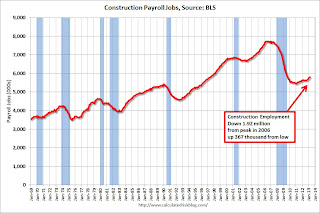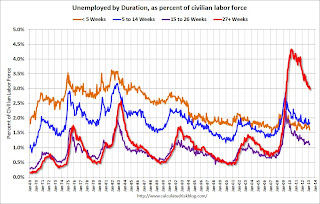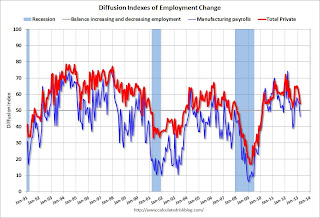Earlier on the employment report:
• March Employment Report: 88,000 Jobs, 7.6% Unemployment Rate
• Employment Report Comments and more Graphs
• All Employment Graphs
A few more employment graphs …
Construction Employment
 Construction is now a positive for the economy.
Construction is now a positive for the economy. Construction employment increased by 18,000 in March (up 91,000 in the first quarter). This still leaves construction with 1.92 million fewer payroll jobs compared to the peak in April 2006, but employment is up 367,000 from the low in January 2011.
I expect residential investment to make a solid positive contribution to GDP growth this year, and for construction employment to continue to increase.
Duration of Unemployment
 This graph shows the duration of unemployment as a percent of the civilian labor force. The graph shows the number of unemployed in four categories: less than 5 week, 6 to 14 weeks, 15 to 26 weeks, and 27 weeks or more.
This graph shows the duration of unemployment as a percent of the civilian labor force. The graph shows the number of unemployed in four categories: less than 5 week, 6 to 14 weeks, 15 to 26 weeks, and 27 weeks or more.The general trend is down for all categories, but only the less than 5 weeks is back to normal levels.
The long term unemployed is just under 3.0% of the labor force – the lowest since June 2009 – however the number (and percent) of long term unemployed remains a serious problem.
Unemployment by Education
 This graph shows the unemployment rate by four levels of education (all groups are 25 years and older).
This graph shows the unemployment rate by four levels of education (all groups are 25 years and older).Unfortunately this data only goes back to 1992 and only includes one previous recession (the stock / tech bust in 2001). Clearly education matters with regards to the unemployment rate – and it appears all four groups are generally trending down.
Although education matters for the unemployment rate, it doesn’t appear to matter as far as finding new employment (all four categories are only gradually declining).
Note: This says nothing about the quality of jobs – as an example, a college graduate working at minimum wage would be considered “employed”.
Diffusion Indexes
 This is a little more technical. The BLS diffusion index for total private employment was at 54.3 in March, down from 59.6 in February.
This is a little more technical. The BLS diffusion index for total private employment was at 54.3 in March, down from 59.6 in February.For manufacturing, the diffusion index decreased to 46.3, down from 54.3 in February.
Think of this as a measure of how widespread job gains are across industries. The further from 50 (above or below), the more widespread the job losses or gains reported by the BLS. From the BLS:
Figures are the percent of industries with employment increasing plus one-half of the industries with unchanged employment, where 50 percent indicates an equal balance between industries with increasing and decreasing employment.
Job growth for both total private employment was fairly narrow for March. This is a not good sign and suggests only a few industries were hiring in March. For manufacturing, more companies were decreasing employment than adding jobs in March.
Earlier:
• Summary for Week Ending April 5th
• Schedule for Week of April 7th